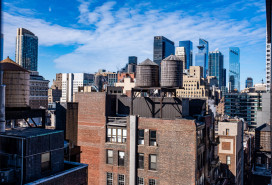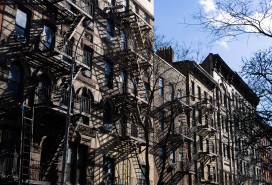6 ways to tell if construction is coming to your NYC neighborhood
Change is inevitable in a city like New York, but it doesn’t have to be a surprise. The city is constantly being reshaped by construction projects that can dramatically impact the quality of life in a neighborhood.
“It’s rare to keep a place exactly as it has always been,” says Andrew Berman, executive director of the Greenwich Village Society for Historic Preservation, which tracks the status of applications for major changes to designated landmarks and historic districts in Greenwich Village, the East Village, and Noho. “People typically care about the character of a neighborhood they are moving to and want to maintain it, and should be aware of changes that are happening there. So you may find an apartment with an amazing view, but recognize that you may not have it forever.”
If you're contemplating a move and want to avoid waking up to jackhammers, or you just want to know what's happening around you, there are many ways to track building projects around New York. Here are seven.
1) Look at Landmarks
The city’s Landmarks Preservation Commission protects the city’s historic and culturally significant buildings. The Landmarks Law requires that building owners get permits before doing work on landmarked buildings and buildings in a historic district. This map shows individual landmarks as well as historic districts in all five boroughs. Start here for information on permit applications and public hearings.
2) Communicate with your community board
Many New Yorkers are unfamiliar with the city’s 59 community boards, which each consist of up to 50 un-salaried members. The boards' main role is to take complaints from community residents, but they also play an advisory role in land use and zoning issues, and they are typically aware of projects that will require public approval. Find your local community board here.
3) Do a block search
The city's Department of Buildings has a searchable online database that is organized by community board. Building on My Block has information on all new buildings, major alterations, and full demolition applications filed with the department. You can search by address or community board to find major projects near you. Professional engineers and registered architects are required to submit simple, 3-D representations of new buildings and enlargements, and those diagrams are also available.
4) Watch the road
Street repair is also a consideration, especially for prospective owners and renters. Resurfacing projects are typically short-term projects that take less than a month. You can see the current resurfacing schedule here.
The type of work that may give a newcomer pause is street reconstruction, which replaces over a foot of the roadway below the street’s surface and usually includes reconstruction of the curbs and sidewalks. These projects can take three to five years from conception to completion. That kind of work is done by the Department of Design and Construction.
In both cases, once a street has been repaired, it becomes a protected street for five years, and the Department of Transportation will not issue a street opening permit there, except for emergency work or for repairs to potholes or other street defects.
5) Keep an eye on public works
The Department of Design and Construction is responsible for building the city’s public buildings, as well as smaller projects such as wheelchair ramps. The agency has a community outreach office that can answer questions and provide updates about ongoing projects in your neighborhood.
Most projects have a construction liaison assigned to help the resident engineer address any community issues and concerns. The resident engineer is responsible for day-to-day activities at construction sites. You can send an email if you have questions about a project.
6) Map the future
If you want to do some serious sleuthing and make some predictions, you can also search "air rights by parcel" on PropertyShark's map tool, to see which building owners have sold off their air rights. Developers use air rights to build taller buildings than the city would otherwise allow. Tracking these transfers can indicate what kind of development is possible in the future, and whether a given neighborhood is poised for tons of development.
You Might Also Like



























